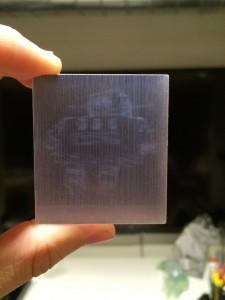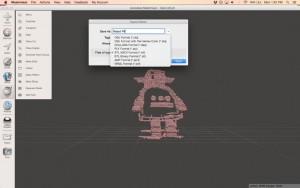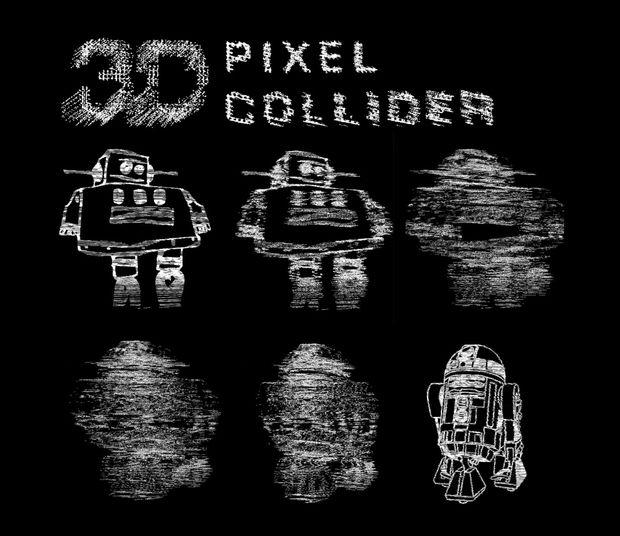Sebastian Morales Prado is a mechanical engineer in Chicago who, as he says, works to merge science and art. A graduate of the Illinois Institute of Technology, Morales now works for SmarterShade Inc. and serves as an artist in residence at Autodesk Pier 9.
“The idea of perceiving things in ways that they are not has always fascinated me,” says Morales. “This project was inspired by thinking about how we could visualize this distorted reality. How to create something that is something else?”
Morales says he used the Processing software suite to automate the creation of what he calls the 3D Pixel Collider rather than manually identifying and repositioning each pixel.
“The idea is to transform this [2D print] into a 3D print, where if seen from one side an image is visible, if seen from another side a completely different image appears,” Morales said of the process.
Processing 2.2.1 is the latest iteration of a programming language, development environment, and online community which debuted in 2001. It’s been downloaded almost two million times, and it was initially created to be a sort of “software sketchbook” and to teach programming fundamentals within a visual context, and the developers have a bit of sense of humor about what they created, as witnessed by their mission statement:
“Processing seeks to ruin the careers of talented designers by tempting them away from their usual tools and into the world of programming and computation. Similarly, the project is designed to turn engineers and computer scientists to less gainful employment as artists and designers.”
Morales turned to Meshmixer, as well as Autodesk Inventor with its Mesh Enabler, to get his .obj file into the appropriately 3D printable .stl file format.
For his 3D Pixel Collider object, Morales first organized the pixels of his two chosen 2D images — R2D2 and the Instructables robot mascot — on the y axis, and he says that was because both 2D images share would share that axis inside the final, 3D printed cube. The finished cube sits atop a light source which illuminates and reveals the images embedded within, providing a clearer look when lit.
“Then I simply replace the ‘z’ coordinate of one image with the ‘x’ of the other, and that is basically it,” he says.
While Morales says he has no formal training in coding, the result is a very cool end product indeed.
You can find detailed information on how Morales made his 3D Pixel Collider, and learn to make your own, in his Instructables.
The 3D printed cube shows, from two opposite sides, one image (R2D2) and on the other two sides, the other image (Instructables’ robot mascot). When looking at the cube from a side or not straight on, the image within is blurred between the two.
What do you think of the 3D Pixel Collider? Will you try to print one out for yourself? Let us know in the 3D Pixel Collider forum thread on 3DPB.com. Check out a short demonstration video, below, showing the images seen at different viewing angles.
Subscribe to Our Email Newsletter
Stay up-to-date on all the latest news from the 3D printing industry and receive information and offers from third party vendors.
You May Also Like
Gorilla Sports GE’s First 3D Printed Titanium Cast
How do you help a gorilla with a broken arm? Sounds like the start of a bad joke a zookeeper might tell, but it’s an actual dilemma recently faced by...
Nylon 3D Printed Parts Made More Functional with Coatings & Colors
Parts 3D printed from polyamide (PA, Nylon) 12 using powder bed fusion (PBF) are a mainstay in the additive manufacturing (AM) industry. While post-finishing processes have improved the porosity of...
$25M to Back Sintavia’s Largest Expansion of Metal 3D Printing Capacity Since 2019
Sintavia, the digital manufacturing company specializing in mission-critical parts for strategic sectors, announced a $25 million investment to increase its production capacity, the largest expansion to its operations since 2019....
Velo3D Initiates Public Offering in a Bid to Strengthen Financial Foundations and Drive Future Growth
Velo3D (NYSE: VLD) has been among a number of publicly traded 3D printing firms that have attempted to weather the current macroeconomic climate. After posting a challenging financial report for 2023,...


































